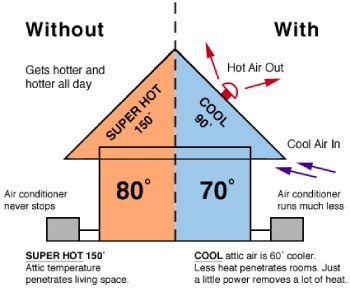An attic fan pulls hot air out of the space and draws in cooler air from outside.
Attic fan to help pool humidity.
Install electric ventilators and attic fans which remove hot air from an attic.
This ventilation process helps lower the attic air temperature and reduce humidity levels thus reducing the.
In the late evening or early morning the fan is turned on to exhaust hot air from the house.
Open your windows before you turn on the fan.
When your air conditioner is working overtime to maintain a cool temperature in your home your energy costs can increase significantly.
An attic fan works by exchanging the hot air in your attic space for fresh air pulled through the vents.
A whole house fan is usually installed on the attic floor near the center of your house.
Positive pressurization also can push moisture into poorly sealed voids inside walls and above ceilings where it can produce mold and deteriorate the building.
This can result in mold rust and deterioration of wood and structural fasteners.
Alternatively install passive vents such as gable soffit and ridge vents which are openings in the roof that allow hot air to escape.
The results are that the attic temperature is close to the outside temperature but the relative humidity is significantly higher in the attic than either the indoor or outdoor readings.
When the air in your attic becomes super heated it can drastically increase the workload on your air conditioner.
Cooler outdoor air enters through open windows lowering the indoor temperature.
Freezing and excessively hot outdoor temperatures rain and high exterior humidity levels make it difficult for your attic fan and heating and cooling systems to keep up with desirable attic.
As the moisture migrates upwards to the colder attic areas during the winter months the relative humidity is increased to the point that condensation can occur on cold surfaces.
A malfunctioning exhaust fan or ventilation design can result in positive pressure and push pool air and odors into connected living quarters.

